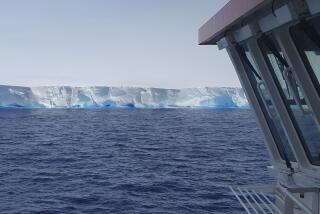U.S. Research Ship Enters Soviet Waters in Joint Exploration Effort
- Share via
In a joint effort with Soviet scientists, a U.S. research ship entered Soviet waters for the first time in a decade Monday, signaling what researchers hope will be a thaw in relations that worsened last year when President Reagan vetoed Soviet participation in a global undersea drilling project.
Researchers aboard the ship Thomas Washington, operated by Scripps Institution of Oceanography, began mapping the sea floor and taking rock samples from the Soviet portion of an undersea plateau in the Bering Sea, about 200 miles east of the Kamchatka Peninsula.
The team includes two Soviet geophysicists who are sharing the results of their own research in the area with Western scientists. Until Monday, the U.S. researchers had been able to study only the half of the plateau that lies underneath international or U.S. waters near the Aleutian Islands. U.S. requests to do research in Soviet waters had been routinely denied by the U.S.S.R.
33-Day Mission
The Soviet data is “absolutely” useful for the planned 33-day mission to the northernmost portion of a chain of volcanoes that stretches from the Hawaiian Islands, said Peter Lonsdale, a Scripps research associate and chief scientist aboard the ship.
“They brought with them all of . . . the data that their ships have collected, so we’re able to choose sites where they don’t have coverage. And we’ve also learned from their data where the most valuable sites to visit are,” Lonsdale said in a telephone interview from the ship.
Reagan’s veto, in April, 1987, kept the Soviets out of the 18-nation Ocean Drilling Program because of Defense Department concern that they would gain access to sensitive high-technology equipment.
To assuage such concerns about security on this voyage, Lonsdale said, the Thomas Washington had taken some “minor” steps, such as locking cabinets containing computers and other electronic equipment.
More than the immediate scientific payoff, scientists were pleased at the potential implications the mission into Soviet waters may have for future joint efforts.
“We hope this marks the beginning of a new era of U.S./U.S.S.R. cooperation in marine research,” said Edward A. Frieman, director of Scripps.
Already, a second mission to study plankton in Soviet portions of the Bering Sea is being planned for September, said George G. Shor Jr., Scripps associate director for ship operations. Soviet scientists will also join that expedition.
Nicklas Pisias, planning committee chairman for the Ocean Drilling Program, for which the United States provides half the funding, said he hopes that the two Soviet approvals will lead to a reversal of the U.S. veto of Soviet participation in that project for exploring the Earth’s history by sampling the ocean floor.
‘Scientific Problems’
“There are scientific problems that can only be addressed by (Soviet) participation or by drilling in the Russian areas,” said Pisias, an oceanographer at Oregon State University.
William Erb, the U.S. State Department’s director of marine sciences, said the Soviets have not brought up Ocean Drilling Program membership during the most recent negotiations.
“My personal view is that any time a relationship improves enough there are opportunities for trying new things,” Erb said.
He attributed the Soviets’ approval of U.S. research in their waters to improving relations between the two countries.
These include the signing in December in Moscow of an extension of a previously moribund treaty promoting joint ocean research, the U.S.-U.S.S.R. World Oceans Agreement. The Scripps expeditions to Soviet waters are the first two trips approved under that extension, Erb said.
More to Read
Sign up for Essential California
The most important California stories and recommendations in your inbox every morning.
You may occasionally receive promotional content from the Los Angeles Times.













